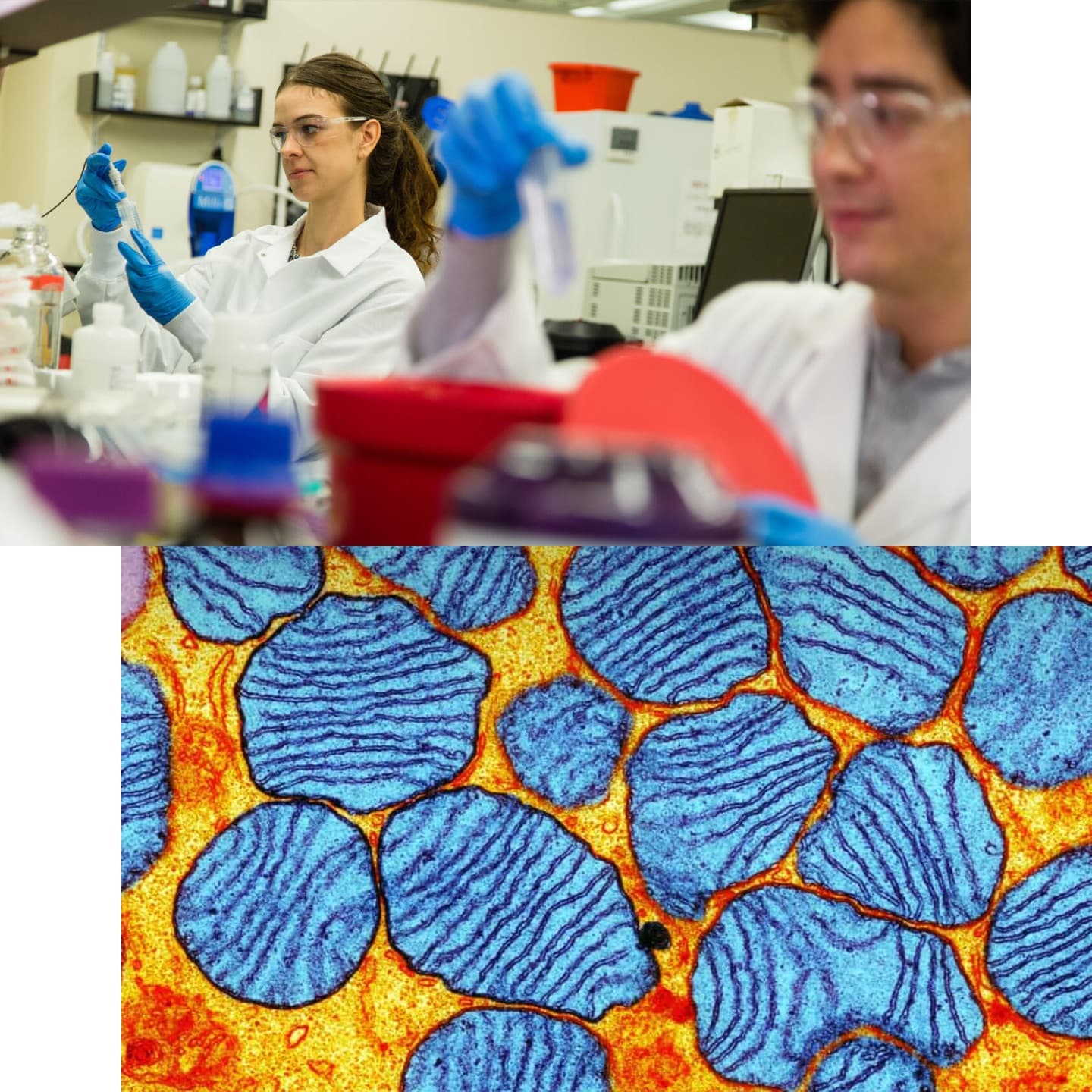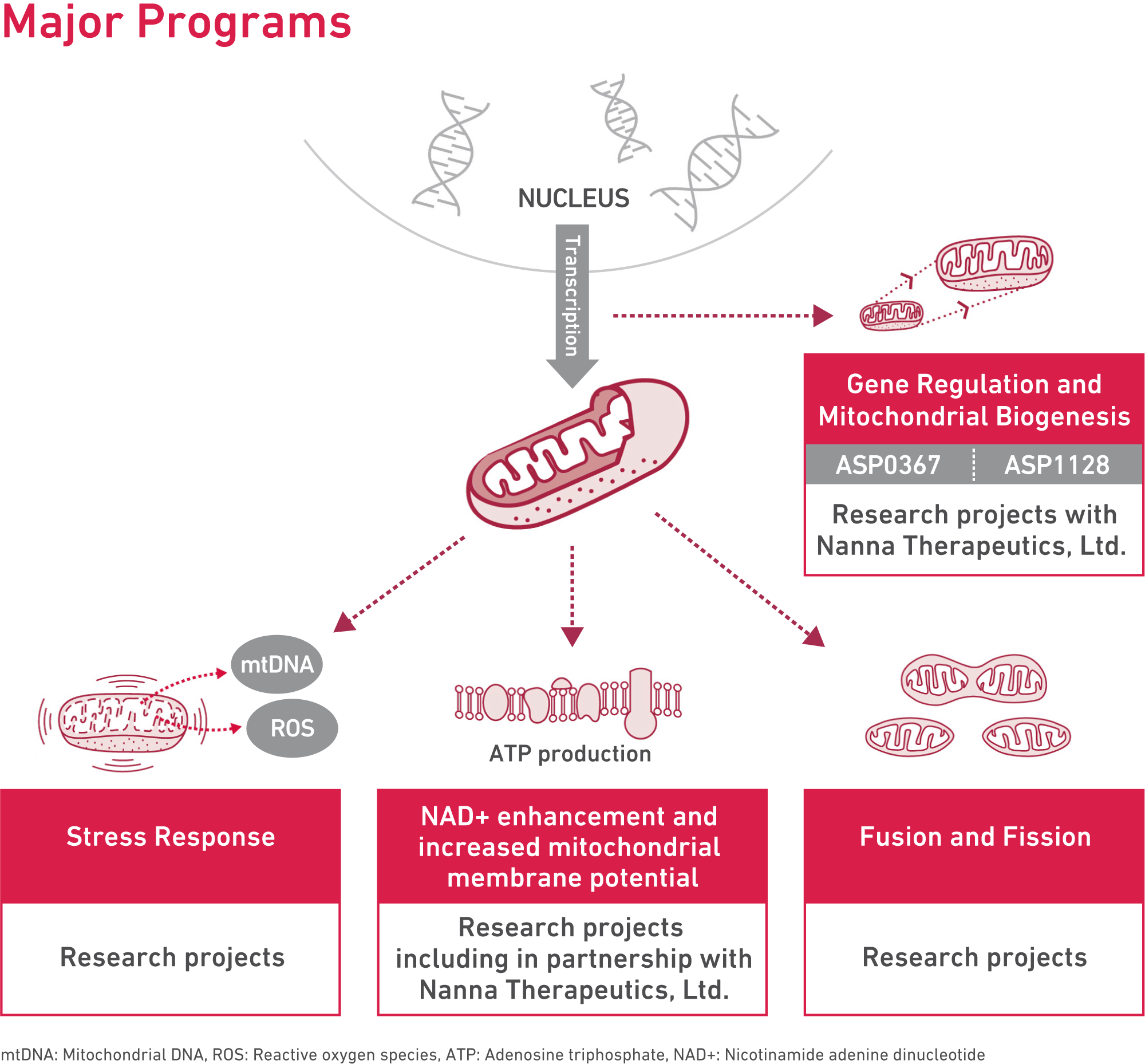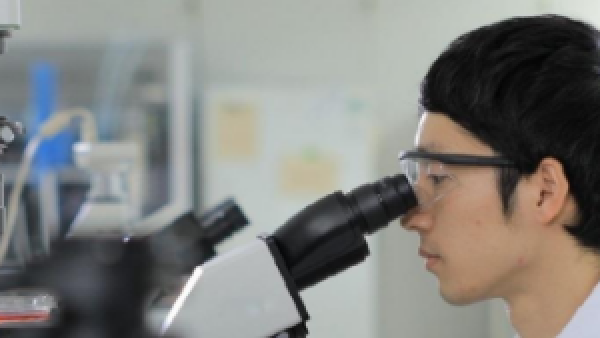Accelerating the discovery and development of novel drugs that target mitochondrial functions.

Primary Focus Mitochondria Biology
-Chapter 1 Primary Focus Lead-
Itsuro Nagase, Ph.D., is working on developing therapeutics for various medical conditions associated with mitochondrial dysfunction.
He first spoke about Mitobridge, which became a wholly owned subsidiary of Astellas in 2018, and the purpose behind it.
“Mitobridge, which focuses on mitochondrial research, is located in the Cambridge, Massachusetts, life science research hub. This area is a mecca of collaboration among individuals and companies in a wide range of industries. Early-stage projects, which is still uncertain to become therapeutics, often come from bio-venture companies rather than large traditional pharmaceutical companies. Generally speaking, large companies lack agility and their decision-making process can delay the start of new projects. By contrast, I think small companies have an advantage because they can move forward on a project with flexibility. I also think these venture companies have a culture of risk-taking. Astellas’ mission as a large player is to leverage the strengths of these venture companies and turn them into big opportunities as transformational products.”
By making Mitobridge a wholly owned subsidiary of Astellas, Astellas did not only obtain its assets, but also gained its capabilities, such as the company’s knowledge and specialties based in its connection and network with other venture companies around the Boston area. Mitobridge has built relationships with many academic institutes through their Scientific Advisory Board, co-led by Howard Robert Horvitz, Ph.D., at the Massachusetts Institute of Technology (MIT), a recipient of a Nobel Prize in Medicine, and Mason Freeman, MD, a professor of medicine at Harvard Medical School with many appointments including the Director of the Translational Medicine Group of the Massachusetts General Hospital (MGH). Mitobridge strengthens our research and development capabilities in the mitochondrial field, specifically, obtaining the Peroxisome Proliferator-Activated Receptor delta (PPARδ) franchise, a result of a collaboration between Ronald Evans, Ph.D. at the Salk Institute in California, and Mitobridge. The PPARδ franchise is the most advanced asset in Mitobridge’s portfolio and will be explained in the Chapter 2 Programs.

The importance of encouraging teams to respect the strengths that partners bring.
He went on to talk about why he was appointed the current position as a Primary Focus Lead. (Please refer to Areas of Interest page for Primary Focus.)
“Prior to leading this Primary Focus Mitochondrial Biology, I was in the US leading a global core team as a Global Development Project Leader for XOSPATA, one of Astellas’ oncology products, collaborating with a wide range of organizations and divisions including R&D, Regulatory Affairs, Marketing, Medical Affairs, Legal, and small diagnostic drug development companies. My experience as a global project leader in M&D, has been vital, in particular, for Astellas’ dealings with venture companies.”
“After joining Astellas, I became a member of the Diabetes Group at Tsukuba Research Center (TRC) and earned my Ph.D. in the area of mitochondrial biology. Getting involved like this in mitochondrial biology again feels to me like fate. My past involvement in mitochondrial research helped me lead this Primary Focus.”
“Due to differences in corporate culture, collaborating with venture companies to create products can sometimes be a challenge. My father ran a small company that wholesaled parts to a certain factory that made glass bottles. It was a small local company with only three employees. Glass Bottles were primary source of revenue at the time, so my father always wished for a hot summer. I saw my father make a great effort to collaborate with a big company. In order to cultivate a collaboration for the sake of his company and employees, he tried to convince his counterpart of his ideas while also avoiding confrontations. While venture companies are proud of their projects and products, typically being able to focus on fewer products, large companies have many products under development and may lack the passion or sense of agility found in venture companies. I think my role as a Primary Focus Lead is to integrate the combined experience and know-how of venture companies and large companies and encourage the teams to have respect for the strengths our partners bring.”
Primary Focus Mitochondria Biology
-Chapter 2 Programs-
Searching for therapeutics for various medical conditions associated with mitochondrial dysfunction.
Have you ever heard of ATP? It is a chemical compound called adenosine triphosphate. It is a combination of adenosine, a base, and three phosphate molecules and is used by all eukaryotes (any organism whose nucleus is present in a cell), including humans, to release and store energy. ATP is produced by the mitochondria by a chemical reaction through cellular respiration when our body cells use the oxygen we breathe to get energy and release carbon dioxide.
Mitochondria play an important role in sustaining life. If its function is impaired, it can cause health issues. For example, when heart surgery is performed, stopping the heart and stopping the flow of blood will reduce oxygen in the body. When blood flows out again, a large amount of oxygen is supplied to the body, and the reactive oxygen can cause tissue damage. The damaged tissue requires a large amount of energy to regenerate, and its energy source is mitochondria. We hypothesized that compounds that enhance mitochondrial function or promote mitochondria biogenesis could be used as therapeutics for various diseases impacted by mitochondrial dysfunction. This is one basic concept behind the Primary Focus Mitochondria Biology initiative.
Programs targeting acute renal failure, duchenne muscular dystrophy, primary mitochondrial myopathy, and others.
First, it is important to understand the molecules that are likely to be involved in functional improvements involving mitochondria, and the relationship between these target molecules and the pathophysiology of diseases. We synthesize compounds that act on a target protein and conditions associated with that target protein and mechanism of action by considering scientific validity. Based on nonclinical studies, we select compounds that can address high unmet medical needs and are eligible for clinical trials. We will seek evidence regarding the usefulness (i.e., efficacy) and the safety of new drug candidates by administering compounds to animals, or humans, and expanding therapeutic opportunities. We classify ongoing projects into four scientific approaches: (1) gene regulation and mitochondrial biogenesis; (2) stress response; (3) NAD+(nicotinamide adenine dinucleotide) enhancement and increased mitochondrial membrane potential; and (4) mitochondrial fusion and fission.

As mentioned above, by making Mitobridge a wholly owned subsidiary, Astellas was able to obtain the PPARδ franchise, which is an output of collaboration between Ronald Evans, Ph.D., at the Salk Institute in California, and Mitobridge. Peroxisome Proliferator-Activated Receptor delta (PPARδ) is known as the master regulator of fatty acid metabolism, and it appears to be involved in increasing mitochondrial output. Those are highly selective PPARδ modulators, the most advanced assets in the Mitobridge portfolio, and we are currently conducting POC (Proof of Concept) clinical trials: ASP0367, an oral formulation, and ASP1128 as i.v. formulation.
Dr. Evans has been a leader in the PPAR area for the last 20 years. There are three PPAR forms: α (alpha), γ (gamma), and δ (delta). Compounds that act on PPARα and PPARγ have been marketed as lipid-lowering drugs and diabetes therapies, respectively. Compounds targeting PPARδ did not reach the market because of a carcinogenic risk. However, Dr. Evans has been studying cancer-suppressing PPARδ for 20 years, and Mitobridge, collaborating with Dr. Evans, has identified the compounds with great promise.

Targeted indications include acute renal failure, Duchenne muscular dystrophy, and primary mitochondrial myopathy, all of which have very high unmet medical needs. There are several other compounds in the Mitobridge pipeline, and we are putting maximum effort into finding evidence of their usefulness and effectiveness for patients.
The challenge of treating unmet medical needs caused by mitochondrial dysfunction.
Primary Focus Mitochondria Biology covers all medical conditions that are impacted by mitochondrial dysfunction, including decreased mitochondrial motility. Unique mitochondrial diseases with severe conditions and with few effective therapeutics are also targeted. Such medical conditions are collectively called mitochondrial diseases and are caused by mutations in genes coding a protein responsible for mitochondrial function or in the mitochondrial DNA itself. They are designated as intractable conditions in Japan. At the Intractable Diseases Information Center operated by the Intractable Diseases Research Foundation, major mitochondrial diseases have been introduced: chronic progressive external ophthalmoplegia syndrome (CPEO), Leigh encephalopathy, mitochondrial disease with stroke-like symptoms (MELAS), and mitochondrial disease with myoclonus (MERRF).
Because mitochondria are present in all the cells throughout the body, symptoms of mitochondrial disease appear in many parts of the body. In addition to subjective symptoms such as muscle weakness and fatigue, other symptoms such as cardiomyopathy and arrhythmia in the circulatory system, convulsion and stroke symptoms in the brain, and irregularities in the endocrine system, may appear. In some cases, one patient can suffer from multiple symptoms.
The U.S. Food and Drug Administration (FDA) granted a Fast Track designation for the development of ASP1128 for patients at risk for acute kidney injury (AKI) in October 2019, and ASP0367/MA-0211 as a potential treatment for primary mitochondrial myopathy (PMM) in October 2020. PMM is a complex mitochondrial disease in which genetic mutations primarily impair the function of mitochondria. We work on the development of effective therapeutics for those mitochondrial diseases that are challenging for pharmaceutical industry.
In addition, Astellas has decided on starting cell therapy with Primary Focus Mitochondrial Biology.
By combining our expertise in mitochondrial biology with AIRM*1's cellular medical platform and Universal Cells*2' universal donor cell technology, the company will take on the challenge of establishing innovative cellular medicine that focuses on mitochondrial functions.
*1 AIRM: Astellas Institute for Regenerative Medicine is a center for research and development of regenerative medicine and cell therapy.
*2 Universal Cells: The company became a member of the Astellas Group in 2018 and owns unique universal donor cell technology, that uses pluripotent stem cells.
Related Links







